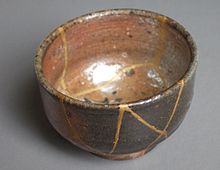Kintsugi
Kintsugi ( Japanese 金 継 ぎ , English “gold connection, patch”) or more rarely Kintsukuroi ( 金 繕 い , “gold repair”) is a traditional Japanese repair method for ceramics. Ceramic or porcelain fragments are glued with Urushi lacquer, missing shards are supplemented with Urushi putty applied in several layers, into which the finest powder gold or other metals such as silver and platinum are sprinkled. Following spreading patterns ( maki-e ) characteristic of Kintsugi decoration effects.
history
Against the background of the spreading Zen Buddhism, a new aesthetic principle - Wabi Sabi - developed in Japan in the 16th century at the instigation of some tea masters, despite the resistance of the wealthy class, who practiced the tea ceremony as a tradition to display glamor and luxury . The Japanese Wabi-Sabi aesthetic ranges from a metaphysical basis to spiritual values, moral regulations and material quality, which is also expressed in the art of tea and has an impact on many areas of art and culture. The focus of this view is on simplicity and the appreciation of flaws. Against this background, Kintsugi - the gold compound that emphasizes the blemish - developed.
literature
- WP Casal: Japanese Art Laquers. Sophia University , Tokyo 1961. ( Monumenta Nipponica Monographs 18)
- Stefan Drescher: kintsugi Technique - kintsugi Technique , 2nd edition - German / English, 2014, Korest restoration needs, ISBN 978-3-00-045016-7 .
- Blake Gopnik: At Freer (Smithsonian's Freer Gallery), Aesthetic Is Simply Smashing. In: Washington Post , March 3, 2009.
- Museum of Lacquer Art : FLICKWERK The Aesthetics of mended Japanese Ceramics. , Exhibition catalog, English, 2008, Münster, ISBN 978-3-93-009021-1 .
